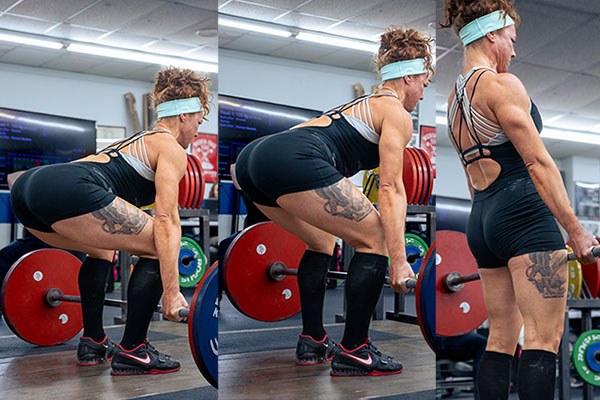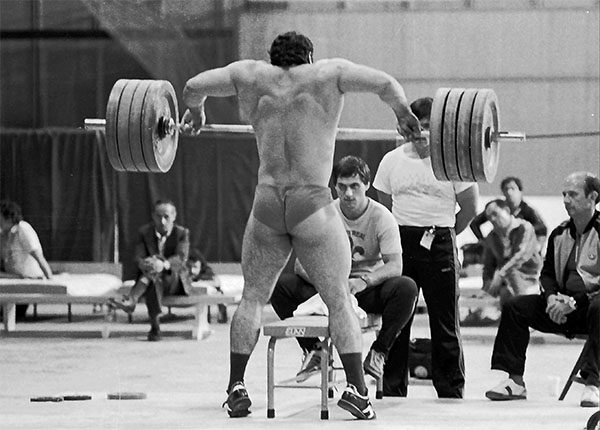
[adinserter block=”2″]
The mechanics of pulling a barbell off the floor have been discussed
rather thoroughly in the Blue Book, and I am continually amazed at
how few coaches appreciate the complexity of the relationship between
loaded bar and the lifter. Briefly, the heavier the load, the closer
the bar must be to a vertical relationship with the middle of the
foot. This isn’t hard to understand if you’ve ever picked up a heavy
awkward object, and then realized why we use barbells that fit
conveniently over the center of balance – your mid-foot.
Olympic lifting coaches
don’t use heavy deadlifts in their programming, and don’t understand
the difference between snatches, cleans, and heavy deadlifts. There
are profound mechanical differences between the lifts that involve
balance, back angle, and acceleration, and as a result the three
lifts produce different training effects. It behooves the coach to
understand these things so that training the pull can be accomplished
efficiently.
Let’s start with the
heavy weight – the deadlift. For our purposes, the difference
between the deadlift and the Olympic pulls is that the deadlift does
not have to be continually accelerated as it moves up. Technically,
it “accelerates” off the floor from 0 velocity to moving, up, but
after that its velocity can remain constant until it locks out on the
thighs. You can grind on a deadlift for 10 seconds and still complete
the pull. A deadlift shows a back angle that becomes more vertical
the higher the bar is from the floor, until lockout in a
slightly-behind-vertical position at the top, with the bar on the
thighs and the mass of the upper body behind the bar, balancing the
mass of the bar over the mid-foot.
In contrast, a clean or a snatch must be accelerated through the
entire pull or it cannot be racked, either overhead or on the
shoulders, because it won’t cover the distance. The change from
pulling to racking the bar must be accomplished under the momentum
imparted to the bar during the pull – you cannot apply force
between the floor and the bar after your feet break contact with the
ground, when you stop pulling and move your feet into the catch
position. Momentum is a function of velocity, velocity is a function
of acceleration, and acceleration is a function of force production –
strength – between hands on the bar and feet on the floor.
This is a very
fundamental consideration. A bar that cannot be sufficiently
accelerated cannot be “racked” in a snatch or a clean. There is
no “grind” – there is only a high-enough, fast-enough pull.
There two reasons why a bar cannot be sufficiently accelerated: 1.)
the inability to produce sufficient force to accelerate the
bar, or 2.) the lifter is in the wrong position to
sufficiently accelerate and catch the bar. Force production is a
function of strength, and correct position is a function of
technique. Strength is produced by training, and
correct technique is acquired through practice.
Squats and deadlifts are strength training for sports, including the
Olympic lifts. If you want to clean 450, it really helps to have a
700 deadlift, and you get to a 700 deadlift 5 pounds at a time over
years of training. The fact that the deadlift is slow and the clean
is fast is certainly true, but the strength developed during
the deadlift (it’s slow because it’s heavy, right?) is the relevant
factor, not the bar speed. If you can pull 700 off the floor slowly,
you can accelerate 450 up to the second pull, because it’s light
enough to move fast. Because you are strong enough. You train
for strength, you practice bar speed. I have actually heard
weightlifting coaches say that it is unnecessary to deadlift more
than 50 kg over your clean, since cleans are fast and deadlifts are
slow, or something like that. This is a profound misunderstanding of
the physics involved here.
The correct position is
the other half of the problem, and it requires a bit of explaining.
Starting Strength is based on a mechanical analysis of the
musculoskeletal relationship between the loaded bar and the human
body. During a pull the bar is on the floor, and the hands connect
the arms, the back, and the hips and legs to the bar. Force generated
against the ground is applied to the bar, the bar accelerates off the
ground and continues upward at a constant velocity or at an
increasing velocity, depending on the mechanical requirements of the
lift and the weight on the bar.
The musculoskeletal
“tool” used to accelerate the bar is the moment arm
between the hips and the bar (see the Blue Book for a comprehensive
discussion of moment forces in barbell training). The longer the
moment arm, the greater the leverage against the hips, but the
greater the mechanical advantage against the bar if you’re strong
enough to operate it. Since a heavy deadlift doesn’t need to be
accelerated, the moment arm from hip to bar in a deadlift can shorten
as the bar comes off the floor – the back becomes more vertical
immediately, reducing the distance between hips and bar.
But for a snatch or
clean, we have to use the longer moment arm to “whip” the bar
through the middle of the pull, accelerating it towards the top to
obtain as much momentum as possible. So, shorter moment arm = less
force from the load against the hips = heavier deadlift. Longer
moment arm = more mechanical advantage against the load = better
acceleration in the snatch and clean if you’re strong enough to
operate the long moment arm. Training the deadlift produces this
strength.
Practicing the snatch
and clean improves your position. Whereas the deadlift back angle
becomes more vertical off the floor, the snatch and clean back angle
should stay as horizontal as possible off the floor for as long as
possible, to retain the longest possible moment arm with which to
accelerate the bar over as much of the bar path as possible. This is
accomplished by starting the pull with a higher hips position than is
usually coached for Olympic lifters. Higher hips produce a more
horizontal back angle and thus a longer hip/bar moment arm. A
low-hips start position pushes the bar forward of the mid-foot, and
doesn’t return the hip/bar moment arm to the best position until
several inches of pull has occurred, costing the lifter the
opportunity to more efficiently accelerate the bar over a longer
distance resulting in a higher bar speed and more momentum.
We have accumulated
quite a bit of convincing video evidence that the bar is pulled
higher with the same weight if a high-hips start is used. The longer
you can accelerate the bar, the higher the bar velocity, and the more
momentum it will have when you stop the pull and start under the
rack. The more momentum the load carries into the top of the pull,
the higher it will travel before gravity catches up and starts it
back down. The more momentum you can impart to heavy weights, the
heavier the weights you can rack.
You have to practice staying out over the bar as you pull your snatches and cleans. The assistance exercises used to train this specific position are the clean-grip deadlift, the snatch-grip deadlift, and the halting deadlift, all of which differ from the deadlift by emphasizing the shoulders-in-front-of-the-bar aspect of the technique. Again, a deadlift gets rid of the hip-bar moment arm as the bar leaves the floor, while the snatch and clean preserves it as long as possible so that longer acceleration can produce higher bar speed.
One aspect of these exercises is the extra work that must be done by the erectors and abs while holding rigid against the longer moment arm produced by keeping the shoulders over the bar. Take a look at the picture of Pisarenko doing the 600-pound high-pull for visual confirmation of the effects of this on the human back. The spine is supported by a circle of muscle mass, and these exercises make situps and back extensions quite irrelevant.

Photo courtesy of Bruce Klemens.
This analysis is fairly comprehensive support for the idea that
Olympic lifters – and everybody else – need to pull heavy from
the floor. If you want to be strong enough to accelerate the bar, you
get that way by adding 5 pounds a workout to your heavy pulls. Strong
= acceleration, and acceleration = heavier cleans and snatches.
Discuss in Forums
[adinserter block=”2″]
Credit : Source Post








